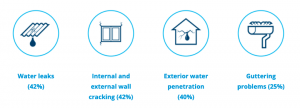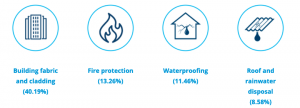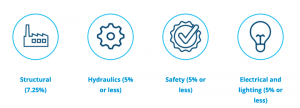Article
Learn About Common Building Defects
July 28, 2021
“Really informative research from the PICA Group explaining what building defects to look out for! Contact our team should you require assistance identifying and managing building defects” – Zac Gleeson, Director
Article originally from the PICA Group
Australia’s most common strata defects and how they become systemic
Knowing your building systems and common building defects can help you spot them and give you some understanding of what specialists look at when they undertake diagnostic reporting. What’s more, knowing where defects most commonly happen also means you can make sure the builders you use have a good reputation in this area.
Common building defects data in Australia has been led by researchers from the City Futures Research Centre and Deakin University, with organisations like PICA Group contributing to funding and studies. Knowing the most common residential defects means better government policy that protects the interests of committee members and owners.
The most common building defects impacting Australian strata properties


Anatomy of building structure
To fully-understand building defects, it’s helpful to have a base understanding of building systems in general and how defects can become systemic. Conceptualising defects and entire building systems can seem a little abstract and hard to understand. To help committees and owners, it can be useful to think of buildings as anatomical structures, like the human body.
Defects can be multifaceted and multi-systemic
Common building defects are complicated and have varying degrees of impact and consequences on a property depending on the type of defect. What’s more, for committees and owners, one of the greatest complications or stressors is the location of the defect because it can so easily turn into multiple defects.
Water ingress and moisture are identified as the defects that have the greatest impact on multiple building systems and are the most prevalent contributor to cross-system defects. Current data shows 43 per cent of defects happen in multiple locations throughout a property, 20 per cent within private lots, 16 per cent on external common property, 10 per cent on internal common property, 7 per cent in car parks, and 4 per cent in utility rooms.
A classic example of one defect that becomes multi-systemic is a waterproofing membrane failure. Here, the defect originates from one element — the membrane. However, membrane failures result in water ingress that affects other construction systems, such as wall cladding. The water ingress typically weakens the structure of the wall cladding creating a further defect, and then flows on to create an interrelated group of defects. The membrane defect could have been triggered for reasons including workmanship or faulty or inappropriate building fabric.
The most common building systems to suffer from defects include:




Properly diagnosing defects via expert reporting is critical to understanding the defects on your property. Not all defects reporting is the same or born equal. Albeit expensive, getting diagnostic reporting correct is critical to the classification of the defect (major or minor) and, therefore, your statutory warranty and ability to hold the builder or developer responsible.
Best practice diagnostics is known as precision reporting (rather than general reporting). Precision reporting is technical reporting of all core building systems and will sometimes involve destructive investigation to get to the root cause (such as putting a hole in a wall to see what the issue is).
Your strata manager or a lawyer that specialises in common building defects should be able to recommend a good diagnostic reporting service.
Source: PICA Group
PICA Group. (2021, May 17). Australia’s most common building defects. https://picagroup.com.au/article/library/australias-most-common-building-defects/#01


